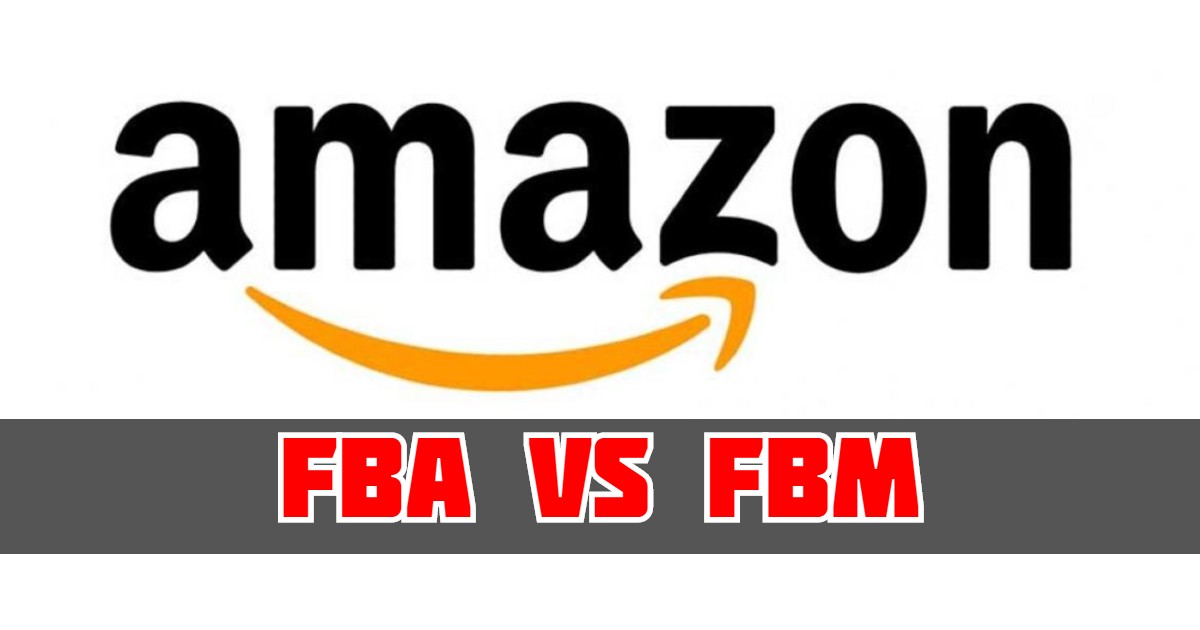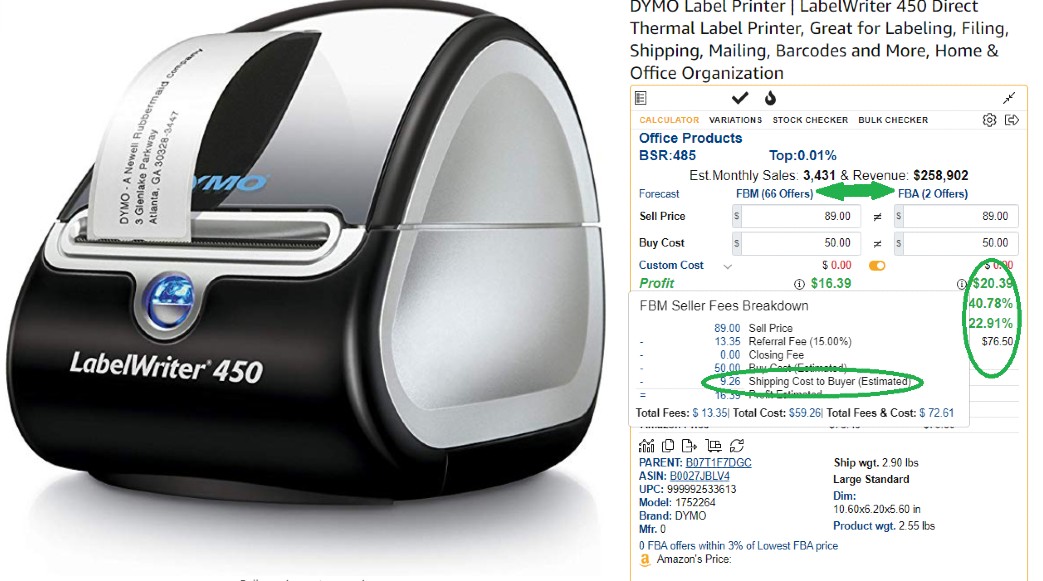As an Amazon seller, you need to determine the best way to get your products into the hands of the customer. You have two basic choices: Fulfill the orders yourself (Fulfillment by Merchant, or FBM)), or take advantage of the Amazon system of order processing known as FBA (Fulfillment by Amazon). Let’s take a look at both options.
When a buyer visits the Amazon marketplace, the products that they purchase may be coming directly from the Amazon Fulfillment Center, or they may be coming straight from the third-party seller’s home or place of business. As a seller, when you add inventory through Amazon Seller Central, you are prompted to decide whether to ship it yourself, or to have Amazon store, process, and ship your items to the customers.
Amazon Merchant Fulfilled orders are shipped by the seller directly to the customer. In this scenario, the person that is selling on Amazon keeps the inventory in their possession. As orders appear in your Amazon Seller Account, you process the order, package the item(s), and ship them to the customer. Amazon deducts their sales commission from the amount paid by the customer, and the balance is credited to your account.
What is Fulfillment by Amazon?
Alternatively, you have the option of processing the inventory and shipping it, in bulk, to one or more of Amazon’s fulfillment centers prior to the items actually being made available for sale. Currently, there are over 100 of these massive warehouses in the US with more being built all of the time. At the time of this writing, Amazon is interviewing 50,000 more people for jobs within the company, most of those being warehouse worker positions. They announced that 100,000 more new jobs would be added in 2018.
Here’s a brief explanation of how Fulfillment by Amazon (FBA) works: Instead of listing and storing the inventory while you wait for a buyer to come along, with FBA you create an inventory file of the items that you want to sell and upload it into Seller Central. You can bulk-upload these using a flat-file, or take advantage of third-party listing software that creates these files for you, behind the scenes, allowing you to upload items individually. Amazon will then determine which warehouse(s) the inventory needs to be sent to. You send the products to Amazon, where they are scanned into inventory and stored. When an item sells, Amazon’s team of well-trained employees (and in some cases Robots) will retrieve the item and ship it to the customer.
Which Method Should I Choose – Fulfillment by Amazon or Fulfillment by Merchant?
There is no one right answer for every Amazon seller. Many sellers use both methods, depending on each individual item that they are selling. Let’s take a look at some of the things to consider when deciding who will ship your products to the customer.
Inbound Shipping Costs
In order for Amazon to ship your products to the customer, you have to have your products in their Fulfillment Center (FC). This means that you will incur shipping charges to get the items to their warehouse. It goes without saying that you will not have to pay this fee if you keep the items in your possession, but this should not be the only determining factor in whether you use FBA.
Amazon is, in fact, one of the biggest customers for UPS and has negotiated shipping rates that very few companies could even hope to ever receive. Amazon allows its third-party sellers (that’s you and me) to ship our inventory to their Fulfillment Centers using their UPS account, meaning that the inbound shipping charges are far lower than you might imagine. And once the inventory is in Amazon’s possession, the real benefits of FBA start to become apparent.
Amazon Prime Membership
Millions of Amazon’s customers are paying $119 per year for Amazon Prime benefits. One of the benefits they receive is Free two-day shipping on most qualifying items. Which items qualify? The ones that Amazon stores and ships from their Fulfillment Centers. This means that sellers who use Fulfillment by Amazon (FBA) as their method of order fulfillment have access to Amazon’s Prime customers. To put this another way, your items that are shipped through Amazon’s FBA program are eligible for Free two-day shipping to the MILLIONS of Amazon’s Prime customers. Are you starting to understand the value of this?
Picture this scenario: You need a new Dymo LabelWriter 450 Turbo for your ecommerce business. You drive around to several stores and compare prices, and then you check Amazon. There are multiple sellers on Amazon who are offering this item and the prices are very reasonable. In fact, the lowest prices are considerably lower than the stores that you checked. You decide to buy from the Amazon website. Seller #1 has the lowest price, and even when you factor in the shipping costs, it is $5 cheaper than the next lowest price. Seller #4 is charging $10 more, but they have the Amazon Prime icon next to their price. This means that you, as a Prime member, will get Free two-day shipping on this item. So you have to make a decision. Do you buy from the seller with the lowest price, or do you pay a little more and have it in your hands within two days?
The lowest price seller has one advantage – Price. But that’s where the advantage ends. If you place an order through a Fulfilled by Merchant seller, they have until the end of the second business day after the order is received to purchase postage and upload the tracking information. So if you order at 9am on Monday, they will have until Wednesday at midnight to show that the item has been shipped before Amazon will consider it to be late. If they print the shipping label Wednesday afternoon, it is considered to be on-time. The Post Office may not receive it until Thursday. Depending on the level of service purchased by the seller, it may take several days or longer between the time it was received at the post office and the time you get it in your mailbox. So the item you ordered on Monday finally arrives next Monday or Tuesday, if you’re lucky, and the seller has met their obligation.
Or, you skip the lowest priced offer and buy the Prime-eligible one. You place the order at 9am on Monday, and it arrives in Wednesday’s mail. Yes, you pay Amazon $119 a year for this benefit. Yes, you may sometimes have to pay a little more for the item itself, since each seller can set their own prices. But isn’t it nice to know that the item you want will be quickly processed and shipped by Amazon, as opposed to waiting for the unknown?
Fulfillment By Amazon is a powerful alternative to Merchant Fulfilling your own orders. Amazon’s Prime customers want their products quickly, so much so that they are paying Amazon for their Prime membership. So much so that they may even be willing to pay a few dollars more than the lowest price just to guarantee the quick delivery of their products. Sometimes they are willing to pay a LOT more.
What Does it Cost to Use FBA
Are there fees associated with using FBA? Of course. Amazon is receiving your items into inventory at their fulfillment center, storing them until they sell, then processing and shipping them when they sell. Their system is very efficient. You can get a breakdown of the fees on Amazon’s Fee Schedule page. The key takeaway is this: Using FBA is VERY LIKELY to increase your sales over what they would be if you only shipped your items Merchant Fulfilled. The fees can be offset by the fact that Amazon Prime customers are far more likely to buy Prime Eligible items, and they are more likely to be willing to pay a little more for those items.
AZInsight Amazon product page Analytics
Get AZInsight! It is a tool that allows you to determine how much your payout would be in a side by side comparison between Fulfillment By Amazon and Merchant Fulfilled. You enter the ASIN of the item that you want to compare, fill in the costs and projected expenses, and the calculator does the rest. But more than just an Amazon revenue calculator, AZInsight will show you your competition’s inventory levels, variations of the product and their price point, whether you are restricted from selling the product, and much, much more. Don’t fall into the trap of buying a whole toolbox full of unrelated tools by different developers that never work well together. AZInsight is the all-in-one Amazon product page analytics tool that you need.

About the Author
Greg Purdy is the founder and co-owner of Seller Essentials, the resource website for all things Ecommerce. He lives in Maryland with his wife and children.
Subscribe to Essential Updates
for more resources, tips, and strategies to help grow your online business.

